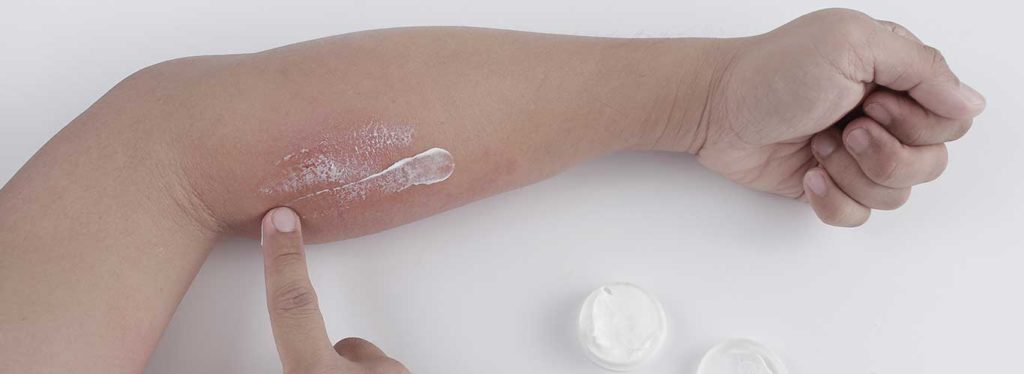News
Feb 4, 2020
World Cancer Day 2020: Looking after your skin during treatment for cancer
The side effects of cancer treatments can be challenging to handle, representing another burden at an already difficult time. It is estimated that over 50% of patients undergoing an anti-cancer treatment develop one or more reactions of the skin, hair or nails. That’s why, today, as part of World Cancer Day 2020, we want to provide some tips on managing the impact of cancer treatments on these areas.
Chemotherapy, and other cancer treatments, work by killing cancer cells or boosting the immune system to fight off the cancer cells. Unfortunately, they often damage healthy cells in the process, causing a number of side effects. The side effects we are going to focus on today are:
- Dry, itchy, and sore skin
- Rashes
- Hair loss
- Nail damage
Please note: It is worth speaking to one of your medical team about the potential side effects of your specific treatment, as we can only provide general information.
Managing dry skin
What you should do: exchange soaps and shower gels for soap substitutes, regularly use an unperfumed emollient, see a healthcare professional if you have severe and persistent issues.

It’s common for people undergoing cancer treatments to have dry or sensitive skin, due to the impact of these treatments on their skin barrier function. Our skin barrier is the outmost layer of skin that prevents potentially harmful things, such as infections, allergens and irritants, from entering the body, as well as preventing excessive water loss.
Soaps, shower gels and bubble baths can make these problems worse. Instead, wash with products known as soap substitutes, these provide moisture to the skin and minimise the risk of irritation and dryness. You can ask your pharmacist to help you find a suitable product.
You should also apply an unperfumed moisturiser (also known as an emollient) regularly. Ideally, this should be around three times per day. Moisturisers help to hydrate the skin as well as creating a barrier to trap in moisture.
Moisturisers and soap substitutes are available to purchase from pharmacies without prescription. If your skin condition is particularly severe or your condition does not improve talk to your medical team for advice.
What to do if you get a rash during cancer treatment
What you should do: Talk to your medical team as soon as possible about how to manage this
If you develop any kind of rash you should inform your medical team as soon as possible. Rashes can change in appearance before your appointment, so it is a good idea to take photos of the affected area to show your doctor. In some types of cancer treatments (targeted therapies) an acne type rash can often develop, however you should not use acne medication as this will further irritate the skin.
Depending on the severity of the rash, you may be prescribed corticosteroid as a cream to be applied directly to the skin or as a tablet taken by mouth. In these circumstances, especially if these treatment options are not effective, you will likely be referred to a dermatologist. There are some rarer, more serious rashes associated with cancer treatments that need to be treated promptly; if in doubt contact/see a member of your cancer team or GP.
How to minimise hair loss
What you should do: Talk to your medical team about the possibility of a scalp cooling cap, which is available at some hospitals in the UK
Some cancer treatments may result in hair loss, and the severity of this will vary from person to person. Hair will most often grow back once treatment has been stopped but it can be very distressing when it happens.
Some people find that cutting their hair very short before starting treatment is beneficial, as this makes the hair loss process more gradual.
Scalp cooling by wearing a special cap during certain treatments such as chemotherapy may reduce or prevent hair loss by reducing blood flow to this area. Your medical team will be able to talk to you about the likelihood of this being effective, and whether your hospital has the facilities for scalp cooling.
If you experience hair loss you may wish to explore options such as wearing a wig. Synthetic wigs may be available on the NHS, you can find more information here.
What to do about nail damage
What you should do: Apply moisturiser or nail oil to dry or flaking nails, if covering up the issue with nail varnish avoid quick drying products
Minor changes to nails during cancer treatments can be well managed. If your nails are dry and flaking, apply a moisturiser or nail oil regularly.
It’s also common for nails to appear differently, such as white lines appearing on the nails. These will grow out over time but if they are bothering you these can be covered up with nail varnish. If you chose to do this, avoid a quick drying nail varnish as these can further dry out the nails.
Some people will experience more troublesome nail problems as a result of their treatment including thickening, lifting up of the nail, altered nail growth and paronychia (inflammation around the edges of the nail often with added infection). If this occurs you are likely to be referred to a dermatologist. It is good practice to try to avoid doing too much wet work, and dry your hands carefully after getting them wet, or wear gloves.
The long-term impact on the skin, hair, and nails
What you should do: Talk to your doctor about any suspected long-term issues, continue to moisturise your skin daily, if photosensitive then be particularly vigilant about protecting your skin from the sun
Most skin, hair and nail changes experienced during cancer treatments are temporary. However, some may persist after treatment ends. It’s recommended that you maintain a good daily moisturising routine once treatment has stopped to prevent dry skin becoming an issue.
Hair loss, nail changes and changes in pigmentation can be permanent in some rare cases. It’s also worth being aware that it is possible for hair to grow back differently, for example the hair may be straight when it was previously curly. Nails often take a long time to recover from treatment due to their slow growth, so don’t worry if you don’t see a fast improvement once cancer treatment is finished. As for improvements in skin pigmentation, this would be expected to be seen by around 12 weeks following treatment.
Photosensitivity as a result of cancer treatments may persist permanently depending on the type of treatment. Studies have shown that skin cancer rates are greater in cancer survivors, therefore it’s important that you continue to protect your skin from the sun after your treatment ends. The British Association of Dermatologists recommends the following:
- Protect the skin with clothing, including a hat, t-shirt and sunglasses
- Spend time in the shade between 11am and 3pm when it’s sunny
- Use a ‘high protection’ sunscreen of at least SPF 30 which also has high UVA protection, and make sure you apply it generously and frequently when in the sun
- Tell your doctor about any changes to a mole or a changing/growing lesion (different patch of skin).
Who to speak to about a skin, hair or nail change?
What you should do: Speak to your Clinical Nurse Specialist (sometimes called your named key worker) about the side effects you’re experiencing

If you’re concerned about any changes to your skin, hair or nails including those mentioned here, your Clinical Nurse Specialist (CNS) or research nurse (if you are in a trial) will be able to discuss these with you in more detail and help you to manage them.
Psychological support
What you should do: Ask about the psychological support options in your area
The side effects of cancer treatments on the skin, hair and nails can be extensive and distressing when they happen. Many will not persist once treatment is finished, however it’s possible that some changes will be permanent.
If you’re struggling to cope with any changes or side effects resulting from your cancer treatment, ask a doctor or a nurse about the support options available to help you with your mental wellbeing. There also tend to be a range of regional and national support groups for people with cancer.

This article was written for the British Association of Dermatologists by Dr Louise Fearfield, Clinical Vice President of the BAD and a Consultant Dermatologist with an interest in skin cancer and cutaneous oncology at The Royal Marsden and Chelsea and Westminster Hospitals.